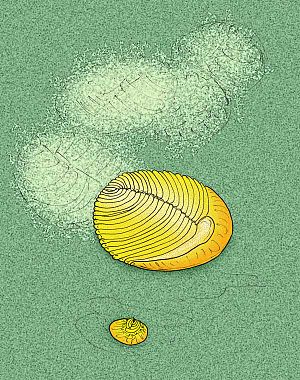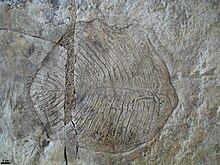Yorgia
| Yorgia | ||||||||
|---|---|---|---|---|---|---|---|---|

Yorgia (reconstruction) |
||||||||
| Temporal occurrence | ||||||||
| Ediacarium | ||||||||
| 560 to 555 million years | ||||||||
| Locations | ||||||||
|
||||||||
| Systematics | ||||||||
|
||||||||
| Scientific name | ||||||||
| Yorgia | ||||||||
| Ivantsov , 1999 | ||||||||
| species | ||||||||
|
||||||||
Yorgia is a genus of extinct creatures . Its currently only known representative, Yorgia waggoneri , lived in the Ediacarium over 555 million years ago and is difficult to compare with living things today. Its fossils are similar to those of Dickinsonia . The systematic classification of Yorgia is controversial due to the numerous, often unique and therefore difficult to interpret characteristics of the fossils. In general, Yorgia is considered an early representative of multicellular animals (Metazoa).
features
Fossil finds from Yorgia show a similarity with those of Dickinsonia and also Spriggina . Yorgia was up to nine inches long. Compared to Dickinsonia , the oval to almost circular body was relatively thick and had a flattened top and bottom. The body was divided into segments or chambers. Yorgia's physique does not follow an exact bilateral symmetry. The first "body segment" following the "head segment" shows a clear asymmetry. Additional depressions on the surface of fossil prints have been interpreted as evidence of organs, possibly gonads .
Way of life
Fossil traces provide little evidence of Yorgia's way of life . It is believed that Yorgia used a feeding mechanism that is now only used by representatives of the Placozoa tribe . Presumably Yorgia grazed over lawns of microorganisms on the ocean floor, digested them externally and ingested them with the help of the entire ventral surface. Alternatively, an autotrophic way of life is being discussed, according to which Yorgia used the symbiosis with unicellular algae or chemoautotrophic bacteria for energy supply.
Trace fossils indicate active or at least passive locomotion.
Systematics
The systematic classification of Yorgia is problematic due to the difficult to interpret characteristics and the largely lacking similarity with organisms living today and is therefore discussed controversially in the literature. Usually the genus is assigned to the realm of the multicellular animals (Metazoa). The first descriptor Andrei Ivantsov assigned Yorgia to the group of Proarticulata , a hypothetical tribe of extinct predecessors of today's bilaterals (Bilateria). Based on the segmentation, an assignment to the trunk group of arthropods is discussed.
The striking deviations of the body structure from bilateral symmetry open up further possibilities for interpretation. Adolf Seilacher assigned Yorgia to the extinct Vendobionts , which he interpreted as large, single-celled organisms. A relationship with the animal strain Placozoa was also discussed.
Discovery story
Yorgia was discovered in the late 1990s by Andrei Ivantsov as part of an annual expedition to the coast of the White Sea in the Russian administrative district of Arkhangelsk and was first scientifically described in 1999. The name of the genus is derived from the site near the Jorga River. The type species Yorgia waggoneri was named in honor of the paleontologist Ben Wagoner .
Web links
Individual evidence
- ↑ a b Ivantsov YA: The new dickinsonid from the upper Vendian of the White Sea Winter Coast (Russia, Arakhangelsk region) . In: Палеонтологический журнал . 3, 1999, pp. 10-11.
- ^ A b c Dzik J: Anatomical information content in the Ediacaran fossils and their possible zoological affinities . In: Integr. Comp. Biol . 43, 2003, pp. 114-126.
- ↑ a b Sperling EA, Vinther J: A placozoan affinity for Dickinsonia and the evolution of late Proterozoic metazoan feeding modes . In: Evolution & Development . 12, No. 2, 2010, pp. 201-209. doi : 10.1111 / j.1525-142X.2010.00404.x .
- ↑ Seilacher A, Grazhdankin D, Legouta A: Ediacaran biota: The dawn of animal life in the shadow of giant protists . In: Paleontological Research . 7, No. 1, 2003, pp. 43-54.
- ↑ Vickers-Rich P, Fedonkin MA: The White Sea's windswept coasts . In: Fedonkin MA (Ed.): The rise of animals: evolution and diversification of the kingdom animalia . Johns Hopkins University Press, Baltimore 2007, ISBN 0-8018-8679-1 , pp. 115-148.


